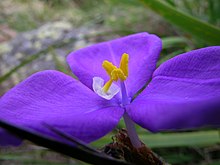Patersonia
| purple flag | |
|---|---|
 |
|
| Patersonia sericea | |
| Scientific classification | |
| Kingdom: | Plantae |
| (unranked): | Angiosperms |
| (unranked): | Monocots |
| Order: | Asparagales |
| Family: | Iridaceae |
| Subfamily: |
Patersonioideae Goldblatt |
| Genus: |
Patersonia R.Br. |
| Type species | |
|
Patersonia sericea R.Br. |
|
| Synonyms | |
|
Genosiris Labill., rejected name |
|
Genosiris Labill., rejected name
Patersonia is a genus of flowering plants in the Iridaceae commonly known as native iris or native flag. It was first described as a genus in 1807 by Robert Brown. It is native to Australia, New Guinea, New Caledonia, and insular Southeast Asia. The genus name is a tribute to the first Lieutenant Governor of New South Wales in Australia, William Paterson.
They are perennials with basal leaves growing from a woody rhizome that in some species extends above ground to form a short trunk. The leaves are tough and fibrous, often with adaptations for conserving moisture, such as stomata sunk in grooves, a thickened cross-section, marginal hairs, and thickened margins.
The flowers appear from between a pair of bracts on a leafless stem. They have three large outer tepals that are usually blue to violet, and three tiny inner tepals. There are three stamens fused at the base to form a tube around the longer style, which bears a flattened stigma.
Several species are grown as garden plants. They can be propagated by seed or by division.
...
Wikipedia
